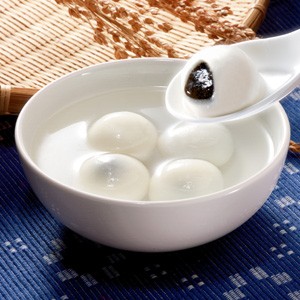For my final Passion Blog on Taiwanese foods, I decided to choose a food that is very difficult to make; Taiwanese Rice Dumplings or “Bah-Tzang” in Taiwanese. There is nothing quite like the exquisite taste, sweet pungent scent, and pyramid-shaped structure of the Taiwanese Rice Dumpling. It is made from sticky rice wrapped with Taiwanese bamboo and can contain a variety of fillings such as pork, mushrooms, shrimp, and other ingredients. The unique thing about Bah-Tzang is that they can even be filled with sweet red-bean paste that surely pleases everyone’s taste buds. What is the best part, you might ask? The entire dumpling is infused with the aroma and delightful taste of bamboo leaves, which I love.
There really is not substitute for this delicious treat that is perfect for any occasion. When my mom first introduced me to this dish when I was a child, I became an instant fan. The soft and moist texture of the dumpling’s inside tasted like nothing I had before. The Bah-Tzang is tied to a true story of a famous poet in China who committed suicide by tying a heavy stone and jumping into a river after his nation’s capital had been overtaken by opposing forces. In order to try and protect his body from fish, the villagers threw Bah-Tzang into the river to get the fish to eat the dumplings instead of the poet’s body. To this day I still love eating Bah-Tzang with my family and talking life. A good dinner starts with the people you love most in life at the table and the delectable meals that complement the experience.
Ingredients
– 5 cups of glutinous rice
– 1/2 pound of dried mung beans
– 20 dried chestnuts
– 1 tablespoon of salt
– 1/8 teaspoon Chinese five-spice powder
– 10 dried black mushrooms , soaked with stems removed and caps sliced
– 20 bamboo leaves
– 1/2 pound pork belly, sliced
Steps
#1) Add glutinous rice, mung beans, and chestnuts to separate bowls
#2) Add enough water to cover the mixture in the bowls and let the bowls soak overnight
#3) Drain the rice, mung beans, and chestnuts before combining them in a large bowl (Do this after the ingredients soak overnight)
#4) Add the salt and five-spice powder and stir to a thick coat
#5) Soften mushrooms by pouring warm water over them. Let the mushrooms soak in the water for 20 minutes. Drain the water.
#6) Cut off the mushroom stems and vertically slice the mushroom caps
#7) Put the bamboo leaves in a large pot
#8) Pour enough water into the pot to cover the bamboo leaves and bring the water to a boil for 10 minutes. Drain the water and let the leaves cool.
#9) Pat the bamboo leaves dry before wrapping.
#10) Place two of the bamboo leaves, slightly overlapping, on a clean table
#11) Add about 1/3 of the rice mixture into the center of the leaves
#12) Top each mound of rice with a slice of pork and a few slices of mushroom
#13) Cover the filling with about 2 tablespoons of rice and the mung bean mixture
#14) Fold the leaves over completely and secure the inside filling
#15) Use string or kitchen twine to lace the dumpling on all sides.
#16) Place the dumplings in a large pot and bring water to a boil
#17) After 4 to 5 hours lower the heat, or when the dumplings are soft and moist. Cook for an additional 4 to 5 hours and add water when necessary.
#18) Drain the water from the dumplings and serve hot. Enjoy!








